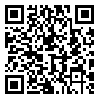BibTeX | RIS | EndNote | Medlars | ProCite | Reference Manager | RefWorks
Send citation to:
URL: http://irje.tums.ac.ir/article-1-5511-en.html
2- Leishmaniasis Research Center, Kerman University of Medical Sciences, Kerman, Iran ,
3- PhD Student of Infectious Diseases, Communicable Diseases Management Center, Ministry of Health and Medical Education, Tehran, Iran
4- PhD Student of Leishmaniasis, Kerman University of Medical Sciences, Kerman, Iran
5- Researcher, Neuroscience Research Center, Kerman University of Medical Sciences, Kerman, Iran
Background and Objectives: Cutaneous leishmaniasis (CL) is a public health problem in Iran and Kerman Province which is expanding to new foci. This study was conducted to estimate the incidence of CL by a simple and cost – effective method in a major focus of CL in the city of Kerman, southeastern Iran.
Methods: A combination of two longitudinal and cross – sectional studies was performed. First, the frequency of referred patients to the CL treatment clinic in 2009-2014 was assessed. Then, four highly infected zones consisting of 800 households in the city were selected. In addition, the relative proportions of referred and non – referred subjects were assessed. Eventually, the incidence of CL was calculated by dividing the number of CL cases over the total at risk population for the corresponding period (2009-2014).
Results: The mean annual incidence was 175 per 100000 (943 patients) in the city of Kerman, while it was 500 per 100000 people (0.5%) in the new foci. The highest CL infection was observed among the <25-year-old individuals but there was no significant difference between the sexes.
Conclusion:The incidence rate probably increased significantly following the 2003 Bam earthquake because of the migration of CL patients to southern, eastern, and northeastern areas of the city of Kerman. Since only 50% of the cases were passively referred to the CL treatment clinic, health authorities should actively detect CL cases by house – to – house visit for effective treatment strategies.
Received: 2016/08/7 | Accepted: 2016/08/7 | Published: 2016/08/7
| Rights and permissions | |
 |
This work is licensed under a Creative Commons Attribution-NonCommercial 4.0 International License. |





